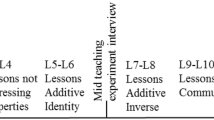Abstract
The present paper describes how 18 forth graders dealt with the problem to find all sums of consecutive integers with a result not bigger than 25. The analysis of the nine interviews that were conducted indicates that all children gradually developed systematic approaches to solve the problem (almost) without intervention of the interviewer.
The contribution puts the research project into a broader context (section 1), presents the arithmetical problem (section 2) and describes the structure of the interviews (section 3). Apart from a general overview regarding the results of the study, one interview with two boys, Alex and Vincent, is discussed in detail (section 4). Finally, conclusions are drawn with respect to the classroom (section 5).
Similar content being viewed by others
Literatur
Bauersfeld, Heinrich (1978): Metagnose mit Problemaufgaben. In: Heinrich Bauersfeld, Michael Otte & Hans-Georg Steiner: Schriftenreihe des IDM, Bd. 18. Bielefeld: IDM, 227–269.
Becker, Jerry P. & Christoph Selter (1996): Elementary School Practices. In: Alan Bishop et al. (Hg.): International Handbook of Mathematics Education. Dordrecht: Kluwer, 511–564.
Carpenter, Thomas P. & James M. Moser (1982): The Development of Addition and Subtraction Problem-Solving Skills. In: Thomas P. Carpenter; James M. Moser & Tom A. Romberg (Hg.): Addition and Subtraction: A Cognitive Perspective. Hillsdale, NJ: Lawrence Erlbaum Associates, 9–24.
De Corte, Erik; Brian Greer & Lieven Verschaffel (1996): Mathematics Teaching and Learning. In: David C. Berliner & Robert Calfee (Hg.): Handbook of Educational Psychology. New York: Simon & Schuster Macmillan, 491–549.
Faust-Siehl, Gabriele et al. (1996): Die Zukunft beginnt in der Grundschule. Empfehlungen zur Neugestaltung der Primarstufe. Frankfurt: Arbeitskreis Grundschule.
Gravemeijer, Koeno (1994): Developing Realistic Mathematics Education. Utrecht: Freudenthal Institute.
Gravemeijer, Koeno (1996): Instructional Design for Reform in Mathematics Education. Position paper for the expert meeting on ‚The role of contexts and models in the development of mathematical strategies and procedures’ at Leiden University. (Erscheint in: Ernest van Lieshout (Hg.): The role of contexts and models in the development of mathematical strategies and procedures. Utrecht: Freudenthal Institute)
Greeno, James B.; A. M. Collins & Lauren Resnick (1996): Cognition and learning. In: David C. Berliner & Robert Calfee (Hg.): Handbook of Educational Psychology. New York: Simon & Schuster, 15–46.
Hasemann, Klaus (1986): Mathematische Lernprozesse. Analysen mit kognitionstheoretischen Methoden. Braunschweig und Wiesbaden: Vieweg.
Hiebert, James et al. (1996): Problem solving as a basis for reform in curriculum and instruction: the case of mathematics. In: Educational Researcher. 25. Jg., H. 4, 12–22.
Hughes, Martin (1986): Children and Number — Difficulties in Learning Mathematics. New York: Blackwell.
Jong, Rob de & Monica Wijers (1993, Hg.): Ontwikkelingsonderzoek. Utrecht: Freudenthal Institut.
Kilpatrick, Jeremy (1992): A History of Research in Mathematics Education. In: Douglas A. Grouws (Hg.): Handbook of Research on Mathematics Teaching and Learning. New York: Macmillan, 3–38.
Krauthausen, Günter (1995): Zahlenmauern im zweiten Schuljahr — ein substantielles Übungsformat. In: Grundschulunterricht. H. 10, 5–9.
Lampert, Magdalene (1986): Knowing, doing, and teaching multiplication. In: Cognition and Instruction. 3. Jg., H. 4, 305–342.
Lange, Jan de (1997): Wereld van verschil — ontwikkelingen in het reken-wiskundeonder-wijs: een international perspectief. In: Tijdschrift voor nascholing en onderzoek van het reken-wiskundeonderwijs. H. 3, 3–12.
Müller, Gerhard N. (1997): Mathematiklemen als konstruktiver, entdeckender Prozeß nicht nur in der Grundschule, sondern auch in der Lehrerbildung — dargestellt an der Arithmetik. In: Peter Bardy (Hg.): Mathematische und mathematikdidaktiksche Ausbildung von Grundschullehrerinnen/-lehrern. Weinheim: Deutscher Studienverlag, 95–113.
Röhr, Martina (1995): Kooperatives Lernen im Mathematikunterricht der Primarstufe. Wiesbaden: Deutscher Universitätsverlag.
Scherer, Petra (1995): Entdeckendes Lernen im Mathematikunterricht der Schule für Lernbehinderte. Heidelberg: Winter.
Schmidt, Siegbert & Werner Weiser (1982): Zählen und Zahlverständnis von Schulanfängern: Zählen und der kardinale Aspekt natürlicher Zahlen. In: Journal für Mathematik-Didaktik. H. 3/4, 227–263.
Schwätzer, Ulrich & Christoph Selter (in Vorb.): Plusaufgaben mit Reihenfolgezahlen — eine Unterrichtsreihe im 4. Schuljahr.
Selter, Christoph & Petra Scherer (1996): Zahlenketten — ein Unterrichtsbeispiel für Grundschüler und für Lehrerstudenten. In: mathematica didactica. H. 2, 54–66.
Selter, Christoph & Hartmut Spiegel (1997): Wie Kinder rechnen. Stuttgart: Klett.
Sierpinska, Anna & Jeremy Kilpatrick (1997): Mathematics education as a research domain: a search for identity. Dordrecht: Kluwer.
Streefland, Leen (1991): Fractions in Realistic Mathematics Education. A Paradigm of Developmental Research. Dordrecht: Kluwer.
Steinbring, Heinz (1995): Zahlen sind nicht nur zum Rechnen da! In: Gerhard N. Müller & Erich Ch. Wittmann (Hg.): Mit Kindern rechnen. Frankfurt: Arbeitskreis Grundschule, 225-239.
Treffers, Adri (1987): Three Dimensions. Dordrecht: Kluwer.Verschaffel, Lieven (1996): Ontwikkelingen in het onderzoek van het reken-wiskundeonderwijs: een international perspectief. In: Tijdschrift voor nascholing en onderzoek van het reken-wiskundeonder-wijs. H. 2, 40–45.
Walther, Gerhard (1984): Problemlosen im Mathematikunterricht einer Hauptschulklasse. In: Pädagogische Welt. 10. Jg., 601–605.
Walther, Gerhard (1985): Rechenketten als stufenübergreifendes Thema des Mathematikunterrichts. In: MATHEMATIKLEHREN. H. 11, 16–21.
Wittmann, Erich Christian (1981): Grundfragen des Mathematikunterrichts. Braunschweig: Vieweg.
Wittmann, Erich Christian (1982): Mathematisches Denken bei Vor- und Grundschulkindern. Braunschweig und Wiesbaden: Vieweg.
Wittmann, Erich Christian (1995): Unterrichtsdesign und empirische Forschung. In: Beiträge zum Mathematikunterricht 1995. Hildesheim: Franzbecker, 528–531.
Wittmann, Erich Christian (1995a): Mathematics education as a ‚design science’. In: Educational Studies in Mathematics. 29. Jg., 355–374.
Author information
Authors and Affiliations
Rights and permissions
About this article
Cite this article
Schwätzer, U., Selter, C. Summen von Reihenfolgezahlen — Vorgehensweisen von Viertkläßlern bei einer arithmetisch substantiellen Aufgabenstellung. JMD 19, 123–148 (1998). https://doi.org/10.1007/BF03338865
Published:
Issue Date:
DOI: https://doi.org/10.1007/BF03338865




